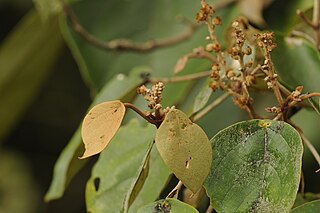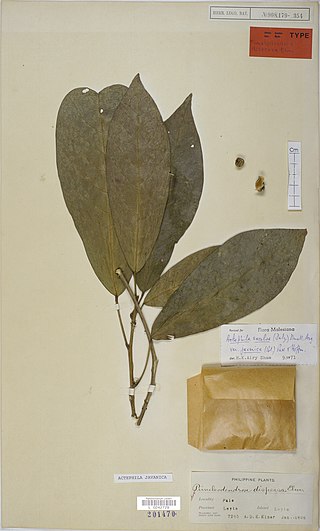
Antidesma is a genus of tropical plant in the family Phyllanthaceae formally described by Linnaeus in 1753. It is native to tropical Africa, S + E + SE Asia, Australia, and various oceanic islands. The greatest diversity occurs in Southeast Asia.

Mallotus is a genus of the spurge family Euphorbiaceae first described as a genus in 1790. Two species are found in tropical Africa and Madagascar. All the other species are found in East Asia, the Indian Subcontinent, Southeast Asia, eastern Australia, and certain islands of the western Pacific. The genus has about 150 species of dioecious trees or shrubs.

Sampantaea amentiflora is a plant species of the family Euphorbiaceae, first described as a genus in 1972. The genus Sampantaea is monotypic and found in Thailand and Cambodia.
Spathiostemon is a genus of trees in the Euphorbiaceae family. It is native to the Bismarck Archipelago, New Guinea, Wallacea and Southeast Asia. The trees grow between 10 and 20m tall, often in secondary forest. The wood is sometimes used.
Mallotus cumingii is a species of plant in the family Euphorbiaceae. It is native to Southeast Asia, occurring in Indonesia, Malaysia, and the Philippines. It is a shrub or small tree growing to 25 m (82 ft) tall.
Syndyophyllum is a plant genus of the family Euphorbiaceae, first described as a genus in 1900. It is native to Sumatra, Borneo, and New Guinea.
- Syndyophyllum excelsum K.Schum. & Lauterb. - New Guinea
- Syndyophyllum occidentale Welzen - Sumatra, Borneo

Breynia is a plant genus in the family Phyllanthaceae, first described in 1776. It is native to Southeast Asia, China, the Indian Subcontinent, Papuasia, Australia, and the island of Réunion.

Mallotus tetracoccus, also known as the rusty kamala, is a species of flowering plant in the family Euphorbiaceae. It is a tree species found in parts of south Asia, typically occurring in the edges of tropical wet evergreen and semi-evergreen forests.

Actephila excelsa is a species of shrub in the family Phyllanthaceae. It is native to an area in Tropical Asia and Zhōngguó/China, from Sulawesi to India and Guangxi. It is a highly variable species and leaf forms vary across adjacent ecozones. The plant is used in building houses and as a vegetable. Grey-shanked douc langurs eat the leaves.

Agrostistachys indica is a species of plant in the family Euphorbiaceae, known in Singapore as the leaf litter plant. The species is widespread across much of Southeast Asia as well as New Guinea, India, and Sri Lanka.

The climbing liana, sometimes a shrub, Mallotus repandus, is a species of plant in the Euphorbiaceae, or spurge, family. It is native to Tropical and Sub-tropical Asia, Wallacea, New Guinea and Queensland on the Australian continent and New Caledonia.
Mallotus floribundus is a tree in the family Euphorbiaceae, in the Stylanthus section, native to Southeast Asia, Wallaceae, New Guinea and the Solomon Islands.
Spathiostemon javensis is a plant that can grow as a shrub or a tree in the tribe Acalypheae of the family Euphorbiaceae. It is native to the region from the Bismarck Archipelago to New Guinea, Wallacea and into Southeast Asia. It is often common in the understorey of forests. The wood is used in constructions.
Spathiostemon moniliformis is a plant that can grow as a shrub or a tree in the Euphorbiaceae family, Acalypheae tribe. It is endemic to southern/peninsular Thailand.
Pantadenia adenanthera is a shrub in the Euphorbiaceae family. It is found in parts of Southeast Asia. The species is used for its wood and edible fruit.

Aporosa octandra is a species of plant in the family Phyllanthaceae found from Queensland and New Guinea to Indonesia, Zhōngguó/China and India. It is a highly variable plant with 4 named varieties. Its wood is used in construction and to make implements, its fruit is edible. The Karbi people of Assam use the plant for dyeing, textile colours have quite some significance in their culture.
Aporosa tetrapleura is a species of plant in the family Phyllanthaceae found in Cambodia and Vietnam. The wood is used in house and cattle barn construction and as firewood.
Senegalia megaladena is a spiny climber, shrub or tree, native to Jawa, and from mainland Southeast Asia to China and India. It is eaten as a vegetable and used as a fish poison. It is named after its distinctive large gland on the petioles.

Uvaria dulcis is a species of woody climber in the Annonaceae family. It is found in tropical Asia, in a disjunctive distribution, eastern Indonesia, Jawa, and then Mainland Southeast Asia. The plant has an edible fruit, which in Khmer language has the colourful name triël dâhs krabéi.

Cleistanthus hylandii, commonly known as Bernie's Cleistanthus, is an evergreen plant in the family Phyllanthaceae which is endemic to Cape York Peninsula in far northern Queensland, Australia.










